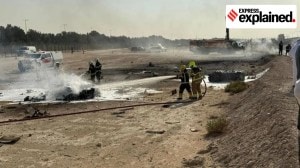Why it matters…
I guess we’ve so enjoyed the photographs of President A.P.J. Abdul Kalam’s family and friends coming all the way by train to Delhi...

I guess we’ve so enjoyed the photographs of President A.P.J. Abdul Kalam’s family and friends coming all the way by train to Delhi from Rameswaram that it’s terribly tempting to slug away at a theory or two. Refrain heroically as one might there does, however, seem a sense of rightness that this good energy came from Dakshin Kashi (‘Varanasi of the South’) as Hindus call Rameswaram.
I’m curious about why it somehow seems to matter. Is it the fugitive pulse of linkage between conflicting aspects of our nationhood? Like North vs South, Hindu vs Muslim? Is it that we are so emotionally exhausted by all the terrible things that have happened to us, that we anxiously scan the dry skies for any hint of raincloud? In the ancient Tamil literature there’s a notion called ‘Aivagai’ or Five Landscapes. The physical landscape of each terrain in Tamil Nadu (shore, river, desert, scrubland, mountain) is supposed to embody a genre of poetry. Each type of poetry represents an emotional state. Thus physical landscape and mental landscape fuse into one complete, multi-layered experience.
Perhaps we hunger for something like that today, in our weeping country? A sense of being wholesomely connected to land and people, the way we supposedly were? The way the Freedom Struggle connected our grandparents so strongly, heart, mind and body pulsing together with millions of unknown heartbeats, from Setu (Rameswaram) to the Himalayas? Is that why there are three movies on Bhagat Singh, a remake of Devdas, a rise in self-awareness and spiritual curiosity? But we lack an easy focus, because the work that needs to be done is slow, patient, boring nation-building, not a dramatic struggle against an oppressor with a flag-hoisting scene at the end. So how do we keep faith? Symbols do help in this struggle. For instance, it matters that President Narayanan spoke so movingly of the high-caste Hindu vote at Ottapalam that elected him, for it is an example.
President Kalam grew up on a historical island, site of the southern-most jyotirlingam of the twelve that knit our sacred geography across Bharat from Kedarnath southwards. Despite our worst cynicism, there IS something powerful in the idea that a place as meaningful as Dakshin Kashi has contributed our First Citizen, who as president of India, represents all billion of us in his person. A pilgrimage to Rameswaram involves mixing water taken from the Ganga into the waters there and collecting local water to go pour into the Ganga. While we peer at the unyielding sky, while the earth cracks under our feet, while our hearts dry for lack of life-affirming experiences, does it not seem obvious that our only hope of nourishment is in bonding and working together, in ‘mixing our waters’?
- 01
- 02
- 03
- 04
- 05































